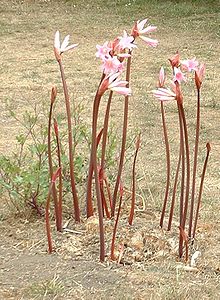Amaryllis belladonna
| Amaryllis belladonna | |
|---|---|

| |
| Scientific classification | |
| Kingdom: | Plantae |
| Clade: | Tracheophytes |
| Clade: | Angiosperms |
| Clade: | Monocots |
| Order: | Asparagales |
| Family: | Amaryllidaceae |
| Subfamily: | Amaryllidoideae |
| Genus: | Amaryllis |
| Species: | A. belladonna
|
| Binomial name | |
| Amaryllis belladonna | |
| Synonyms[1] | |
|
Species synonymy
| |
Amaryllis belladonna,
Description
Taxonomy and etymology
Amaryllis belladonna is one of the two species in the genus Amaryllis as currently circumscribed.[8]
The specific epithet belladonna is derived from the Italian bella donna, which means beautiful lady.[9]
Habitat

Amaryllis belladonna is found in South Africa, where the plants are found growing among rocks.[5]
Ecology
Leaves of A. belladonna begin growing in early spring, or during late autumn. They last for a few weeks to a few months until they wither away, and a flower stalk will begin growing. When found in the wild, Amaryllis belladonna is pollinated by
All parts of the A. belladonna plant are toxic and contain several different alkaloids, such as
Cultivation
The bulbs are best planted just below the surface of the soil, with the neck of the bulb level with the surface. In colder climates
Medicinal properties
Several compounds have been found in A. belladonna bulbs, including, 1,4-dihydroxy-3-methoxy powellan, which is an alkaloid. It has been observed that alkaloids in this plants bulb have properties to fight against malaria caused by P. falciparum.[12]
See also
References
- ^ Amaryllis belladonna, The Plant List
- ^ Linnaeus, Carl (1753). Species Plantarum. Vol. 1. p. 293 – via Biodiversity Heritage Library.
- ^ BSBI List 2007 (xls). Botanical Society of Britain and Ireland. Archived from the original (xls) on 26 June 2015. Retrieved 17 October 2014.
- ^ a b c RHS 2015.
- ^ a b c d Phipps 2011.
- ^ "Amaryllis belladonna". Kew World Checklist of Selected Plant Families.
- ^ "Amaryllis Belladona distribution map". Biota of North America Project.
- ^ "Search for Amaryllis". World Checklist of Selected Plant Families. Royal Botanic Gardens, Kew. Retrieved 1 February 2015.
- ISBN 978-0-521-86645-3.
- .
- ^ "Is Amaryllis Belladonna Toxic?". Garden Guides. Retrieved 19 February 2021.
- PMID 29162457.
Bibliography
- RHS (2015). "Amaryllis belladonna: belladonna lily". Retrieved 1 April 2015.
- Dressler, S.; Schmidt, M. & Zizka, G. (2014). "Amaryllis belladonna". African plants – a Photo Guide. Frankfurt/Main: Forschungsinstitut Senckenberg.
- Carter, Kathie. "Amaryllis. Amaryllis belladonna (Brunsvigia rosea) and Hippeastrum hybrids" (PDF). Center for Landscape and Urban Horticulture. Cooperative Extension/Botany Plant Sciences Dept. University California Riverside. Retrieved 24 January 2015.
- Phipps, Nikki (9 February 2011). "Amaryllis Belladonna Planting – How To Grow Amaryllis Bulbs". Planting Flower Bulbs. Archived from the original on 24 January 2015. Retrieved 1 April 2015.
- Adams, T. (2001). "Amaryllis belladonna L." PlantZAfrica.com. South African National Biodiversity Institute. Retrieved 2 April 2015.
![]() Media related to Amaryllis belladonna at Wikimedia Commons
Media related to Amaryllis belladonna at Wikimedia Commons
